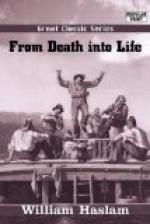I put a notice in the newspapers, inviting people to come and see the old church which had been buried for fifteen hundred years. In the presence of many visitors, clerical and lay, we removed the stones of the altar, and found the skeleton of St. Piran, which was identified in three ways. The legend said that he was a man seven feet high; the skeleton measured six feet from the shoulder-bones to the heel Again, another legend said that his heart was enshrined in a church forty miles away; the skeleton corresponded with this, for it was headless. Moreover, it was said that his mother and a friend were buried on either side of him; we also found skeletons of a male and female in these positions. Being satisfied on this point, we set the masons to work to rebuild the altar tomb in its original shape and size, using the same stones as far as they would go. We made up the deficiency with a heavy granite slab.
On this I traced with my finger, in rude Roman letters, “Sanctus PIRANUS.” The mason would not cut those crooked letters unless I consented for him to put his name in better ones in the corner. I could not agree to this, so his apprentice and I, between us, picked out the rude letters, which have since (I have heard) been copied for a veritable Roman inscription.
My name was now up as an antiquary, and I was asked to be the secretary (for the West of England) to the Archaeological Society. I was supposed to be an old gentleman, and heard myself quoted as the “venerable and respected Haslam,” whose word was considered enough to settle a knotty point beyond doubt. I was invited to give a lecture on the old Perran Church, at the Royal Institution, Truro, which I did; illustrating it with sketches of the building, and exhibiting some rude remains of carving, which are now preserved in the museum there.
The audience requested me (through their chairman) to print my lecture. This I undertook also; but being very young in literary enterprises, I added a great deal of other matter to the manuscript which I was preparing for the press. There was much in the book * about early Christianity and ecclesiastical antiquities. I imagined that this parish was, in British and Druidic times, a populous place, and somewhat important. There was a “Round,” or amphitheatre, for public games, and four British castles; also a great many sepulchral mounds on the hills, the burial-place of chieftains. I supposed that St. Piran came here among these rude natives (perhaps painted savages) to preach the Gospel, and then built himself a cell by the sea-shore,+ near a spring or well, where he baptized his converts. Close by, he built this little church, in which he worshipped God and prayed for the people.
________________________________
* “The Church of St. Piran.” Published by Van Voorst. + This little building still remains entire, under the sand. Some pieces of British pottery and limpet-shells were found outside the door. ________________________________




